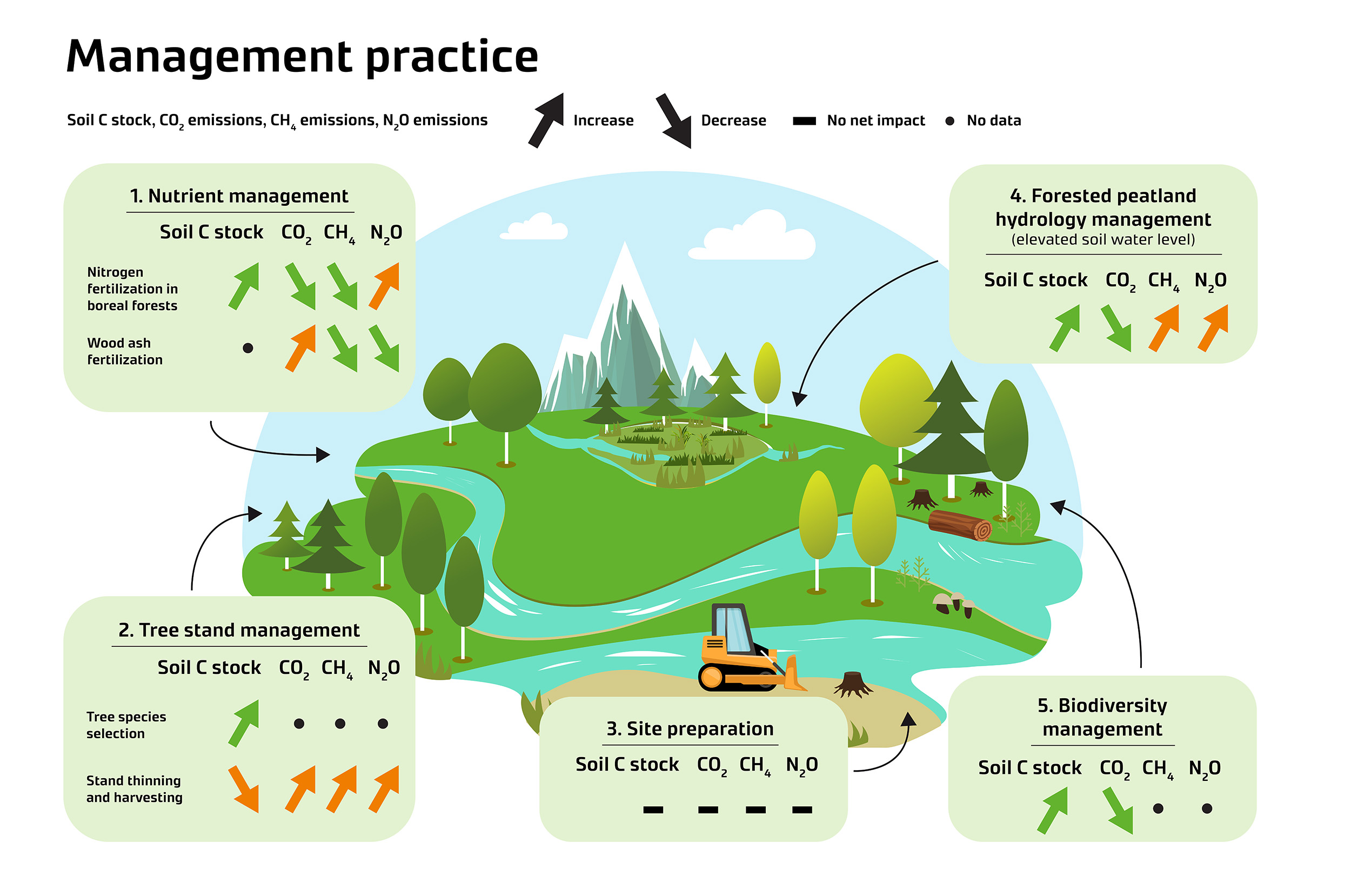Authors: Mäkipää, R., Abramoff, R., Adamczyk, B., Baldy, V., Biryol, C., Bosela, M., Casals, P., Jorge Curiel Yuste, Dondini, M., Filipek, S., Garcia-Pausas, J., Gros, R., Gömöryová. E., Hashimoto, S., Hassegawa, M., Immonen, P., Laiho, R., Li, H., Li, Q., Luyssaert, S., Menival, C., Mori, T., Naudts, K., Santonja, M., Smolander, A., Toriyama, J., Tupek, B., Ubeda, X., Verkerk, P.J., Lehtonen, A.
The European Union aims to be climate neutral by 2050 under targets set in the Paris Agreement. Forest soils contain larger amounts of carbon (C) than standing biomass. Forest management can both increase and decrease carbon stock, soil CO2 emissions, and net exchange of other greenhouse gases (GHG) such as methane (CH4) and nitrous oxide (N2O). Increasing the carbon sequestration in forest soils and reducing net GHG emissions is crucial to achieve the target.

What do we know?
Forest management practices contribute to climate change mitigation by affecting soil carbon stocks and GHG fluxes in temperate and boreal forests:
- Nitrogen and wood ash fertilization in boreal forests/peatlands can lead to soil carbon stock increase: depending on the nutrient status, both forest productivity (trees and understory vegetation, fungi) and litter input to soil can be increased, subsequently increasing soil C stock.
- Tree species selection can increase soil carbon stock accumulation: species’ adaptation to site and environmental conditions enhances forest productivity and litter input to the soil. Stand thinning and harvesting affect soil carbon increase and/or loss: High intensity thinning and clearcut harvesting result in soil carbon loss, and higher CO2 and GHG emissions.
- Removal of harvest residues reduces soil C stock, but site preparation has both positive and negative impacts.
- Peatland hydrology management can reduce emissions of drained organic forest soils: avoiding clearcutting by continuous cover management, avoiding further ditching, and raising the soil water level (up to 30 cm depth of root layer) all reduce total GHG emissions.
- Biodiversity management, e.g. protection areas that have high biodiversity value and high carbon stock, can have a positive impact on soil carbon sequestration.
A current issue in the Mediterranean: although forest fires damage soils, the use of fire as a management tool has less negative, or even neutral or beneficial effects on soil properties.
What are the policy implications?
- Forest soil responses to management practices must be better accounted for, when evaluating and implementing forest-based climate change mitigation measures. Creating awareness of the importance of soil mitigation potential enhances climate change mitigation.
- Important knowledge gaps exist in understanding how soil carbon balances and GHG emissions are affected by forest management, climate, biodiversity loss, and other environmental changes, as well as their trade-offs.
- Climate-smart forest management practices depend on site-specific conditions. The effect of management on soil depends on management intensity, soil type (organic/mineral soil) and conditions (nutrients, moisture, pH), topography, vegetation composition, climate conditions as well as recovery time after management.
- The effects of forest management practices on soils are not yet widely integrated into existing modelling tools for decision making, risking that these effects are not properly considered when designing policies to achieve climate neutrality targets.
- Long-term soil monitoring is needed to verify targeted changes in soil carbon sequestration and reductions of GHG emissions to confirm which management practices are efficient in climate change mitigation.
Reference
Mäkipää, R., Abramoff, R., Adamczyk, B., Baldy, V., Biryol, C., Bosela, M., Casals, P., Jorge Curiel Yuste, Dondini, M., Filipek, S., Garcia-Pausas, J., Gros, R., Gömöryová. E., Hashimoto, S., Hassegawa, M., Immonen, P., Laiho, R., Li, H., Li, Q., Luyssaert, S., Menival, C., Mori, T., Naudts, K., Santonja, M., Smolander, A., Toriyama, J., Tupek, B., Ubeda, X., Verkerk, P.J., Lehtonen, A. 2023. Forest soils can increase climate change mitigation with targeted management. Policy Brief 7. European Forest Institute. https://doi.org/10.36333/pb7
Holistic management practices, modelling and monitoring for European forest soils – HoliSoils – is funded by the European Commission’s Horizon 2020 research and innovation programme under grant agreement no. 101000289.
The project has made translations available in Bosnian, Catalan, Chinese, Dutch, Finnish, French, German, Japanese, Polish, Portuguese, Slovak and Spanish.
Visit the HoliSoils website to access the translations